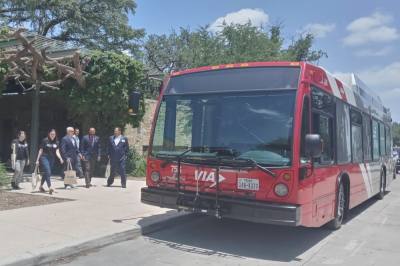Delivering a State of Transit address June 17, the head of VIA Metropolitan Transit said his agency has plans to bolster ridership and improve public transportation around San Antonio.
VIA President/Chief Executive Officer Jeffrey Arndt was the keynote speaker in the San Antonio Mobility Coalition’s annual State of Transit luncheon at the Witte Mays Family Center.
Arndt said federal COVID-19 relief monies are allowing VIA to begin accelerating key parts of the agency’s Keep San Antonio Moving plan.
Local voters back in November 2020 approved imposing an additional one-eighth of $0.01 sales tax to support launching a range of mass transit projects in 2026, including VIA Link hubs linking VIA customers with on-demand mobility options such as rideshares in places where traditional bus routes are not feasible.
Arndt said, however, pandemic relief funds are allowing VIA to move up planning for this and other transit-improvement projects contained within the estimated $38.5 million Keep San Antonio Moving program.
According to VIA, the long-range KSAM plan includes development of an advanced rapid transit system designed to move riders quickly through major corridors, and an enhanced bus system with reduced wait times, easier tripes and expanded real-time information.
“That’s the exciting news—that we’re moving forward,” Arndt said.
Arndt said these and other ongoing and future improvements are meant to upgrade the total ridership experience for people use VIA to get to work, school, errands or recreation.
Arndt pointed to VIA customer experience surveys conducted in February 2022; survey results show that 93% of VIA riders rely on local public transit for any type of travel in town, and that 57% of riders use VIA solely to get to their job.
About 48% of survey respondents have household incomes of less than $25,000 per year. Other survey results showed that 42% of riders choose mass transit to save on gasoline costs, a number that Arndt said is rising because of inflation and increasing gas prices.
More customer surveys showed that increasing frequency of mass transit pick-ups and drop-offs, shorter travel time and convenient hours of operation are the elements of VIA service that are most important to riders, Arndt said.
Arndt said these and other reasons are why it is vital for VIA to continue planning for implementation of measures—such as VIA Link ridesharing—to upgrade the riders’ experience.
Arndt said VIA plans to open four new VIA Link hubs around town between now and the end of 2023. People wishing to use VIA Link, VIA’s traditional bus service, VIAtrans paratransit service or special event services may buy tickets for any of those services using VIA’s improved goMobile app, which was launched last summer.
In addition to opening a Keep San Antonio Moving public office along San Pedro Avenue this year, VIA plans to open in July a new VIAtrans facility at the former Graham Central Station nightclub at 4902 Fredericksburg Road, just north of Balcones Heights. Arndt said the 11-acre site will house the agency’s VIAtrans operations and fleet vehicles.
Arndt said plans are moving forward on what would be San Antonio’s first Advanced Rapid Transit corridor, a north/south route that would provide frequent mass transit service within dedicated lanes and outside of regular traffic lanes.
VIA officials confirmed last March that the Federal Transit Administration has recommended $158 million in funding toward designing and building the total, estimated $320 million ART corridor. VIA officials said the VIA’s ART project is the lone Texas public transportation project added to President Joe Biden’s funding recommendation list for the nation’s Fiscal Year 2023 budget.
VIA will hold public meetings on its rapid transit plans:
- 9:30-11:30 a.m. June 25 at Blessed Sacrament Church, 600 Oblate Drive, San Antonio;
- 5:30-7:30 p.m. June 29 at Norris Conference Center, 618 N. Loop 410 We., Balcones Heights;
- 5:30-7:30 p.m. July 12 Hermann Sons Lodge, 525 S. St. Mary’s St., San Antonio.
Even with inflation and other potential economic issues, Arndt said it is important for VIA and its public and private partners, such as the city of San Antonio, Bexar County and the mobility coalition, to maintain momentum on these and other mass transit projects.
“The time is now and we are on fire and we are in the fast lane, but we need to take advantage of any opportunity,” Arndt said.






